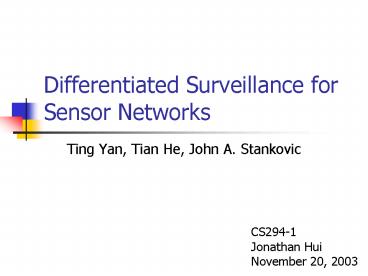Differentiated Surveillance for Sensor Networks - PowerPoint PPT Presentation
1 / 17
Title:
Differentiated Surveillance for Sensor Networks
Description:
Time Synchronization. Uniform expected node lifetime. For simplicity of describing protocol? ... Coverage provided for longer period of time. 14. Evaluation ... – PowerPoint PPT presentation
Number of Views:36
Avg rating:3.0/5.0
Title: Differentiated Surveillance for Sensor Networks
1
Differentiated Surveillance for Sensor Networks
- Ting Yan, Tian He, John A. Stankovic
CS294-1 Jonathan Hui November 20, 2003
2
Idea
- Exploit node density/redundancy to maximize
effective network lifetime. - Degree of coverage matters!
- Sensing constraints
- Fault tolerance
3
Assumptions
- Static placement
- Localization
- Time Synchronization
- Uniform expected node lifetime
- For simplicity of describing protocol?
- Nodes on 2D plane
- Circular sensing radius r
- Communication range gt 2r
4
Basic Protocol
- Initialization Phase
- Localization, Time Sync, Determine Working
Schedule (T, Ref, Tfront, Tend) - Sensing Phase
- Nodes power on and off based on working schedule
Round 0 (T)
Round 1 (T)
Round i (T)
Ref
Ref
Ref
t
Tfront
Tend
Tfront
Tend
Tfront
Tend
Sensing Phase
Init Phase
5
Basic ProtocolDetermining Working Schedule
- Goal Each node determines its own working
schedule such that all points within sensor
coverage are covered for all time. - Approach Represent sensor coverage with grid of
points
6
Basic ProtocolDetermining Working Schedule
- Reference Point Scheduling Algorithm
- Randomly choose Ref from 0, T) and broadcast to
all nodes within 2r. - For each discrete point
- Order neighboring Ref times and calculate
- Tfront Ref(i)-Ref(i-1)/2
- Tend Ref(i1)-Ref(i)/2
- Final schedule union of schedules for all points
RefA
RefB
RefC
Point 1
RefA
RefB
RefC
Node A
RefA
RefD
RefE
RefD
RefE
Point 2
7
Enhanced Protocolwith Differentiation
- Working schedule for a desired coverage of degree
a. - (T, Ref, Tfront, Tend, a)
- Working period defined as
- Power On
- Power Off
Example (a 1)
RefB
RefC
RefA
A
B
C
8
Design Issues
- Possible blind spots with discrete points
- Choose points within sensing range conservatively
- Offset in time synchronization
- Power on (off) slightly earlier (later)
- Irregular sensing regions
- Okay, as long as sensing regions of neighboring
nodes are known - But also requires knowledge of orientation
- Fault Tolerance
- Awake nodes use heartbeat messages to detect
failed nodes - If a node fails, wakeup all nodes within 2r and
reschedule. - What if communication range lt 2r?
9
Extensions and Optimizations
- Second Pass Optimization
- After determining working schedule, broadcast
schedule to all nodes within 2r. - The node which has the longest schedule
- Minimize Tfront and Tend while maintaining
sensing guarantee - Rebroadcasts new schedule
- Done when every node has recalculated schedule or
when no more can be done.
10
Extensions and Optimizations
- Multi-Round Extension for Energy Balance
- Calculate M schedules each with different Ref
values during Init Phase. - Rotate schedules during Sensing Phase.
RefB
RefA
RefA
RefB
RefC
RefC
RefB
RefA
RefC
RefA
RefB
RefC
A
B
C
Schedule 1
Schedule 2
Schedule 3
Schedule 4
11
Evaluation
- Simulation parameters
- Nodes distributed randomly with uniform
distribution in 160mX160m field. - Results taken from center 140mX140m to avoid edge
effects - Sensing range 10m
- Communication range 25m
- Ideal conditions
- Fault tolerance included?
- Compare against sponsored approach
12
Evaluation
- Total energy consumption nearly constant with
changes in density.
- Variation in total energy consumed decreases with
greater densities. - Whats happening with the sponsored approach?
13
Evaluation
- Half-life increases linearly as density increases.
- Coverage provided for longer period of time.
14
Evaluation
- Energy consumption increases linearly with
different degrees. - Energy consumption constant with different
densities.
- Degree of coverage provided gt a.
- a only guarantees a lower bound.
15
Comments
- Localized algorithm?
- But still requires time synchronization and
doesnt support mobility - Inflexible
- mobility not supported, schedules are fixed
- No notion of the goodness of a node
- Nodes that have more energy should take up a
larger portion of the working schedule - Difficult to reliably broadcast Ref values to all
2r neighbors in a dense network - Only have one chance to get it right!
- Worse in cases where communication range lt 2r
(i.e. acoustic sensors)
16
Comments
- Working schedules determined without taking other
schedules and protocols into account - How does it affect other protocols (i.e. TDMA)?
- Comparison to Sponsored Coverage unfair
- Sponsored Coverage supports fault tolerance,
limited mobility, and is more adaptable - Ability to specify degree of coverage
- But current algorithm doesnt correctly guarantee
with a gt 2! - Fault tolerance relies on communication range gt
2r for heartbeat messages
17
Conclusion
- Pros
- Improved performance in lifetime and workload
balance - Specify a degree of coverage
- Cons
- No upper bound on degree estimation
- Inflexible
- Static working schedule, static nodes, time
synchronization, reliable communication































